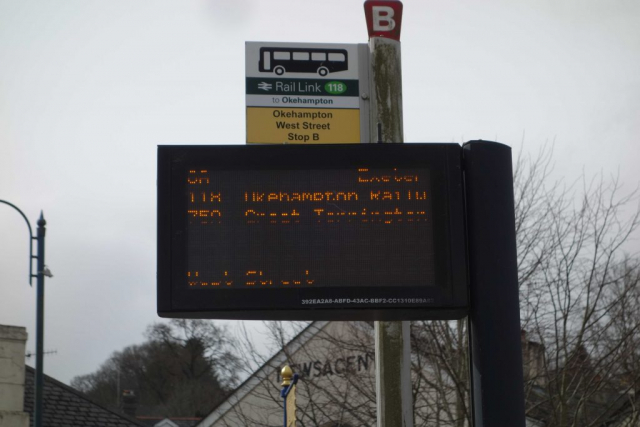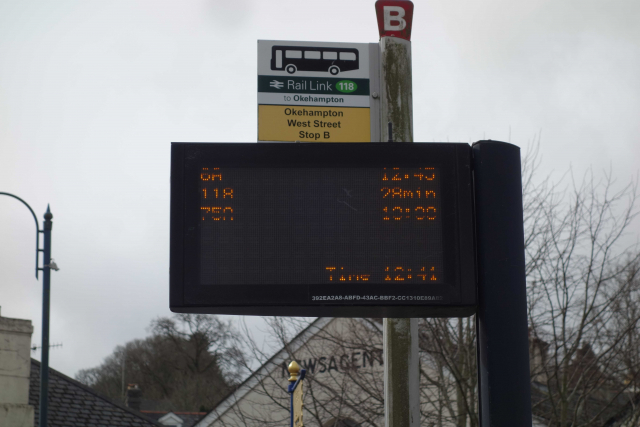The triumphalism which was shown as the resumption of a regular train service approached in late 2021 made it sound as if Okehampton had been cut off from the world since 1972. The trains were to be a great improvement on the bus service, which was said to be slow and unreliable. The scout thought he should catch the bus to Okehampton to see how it compared, or whether comparison was fair.
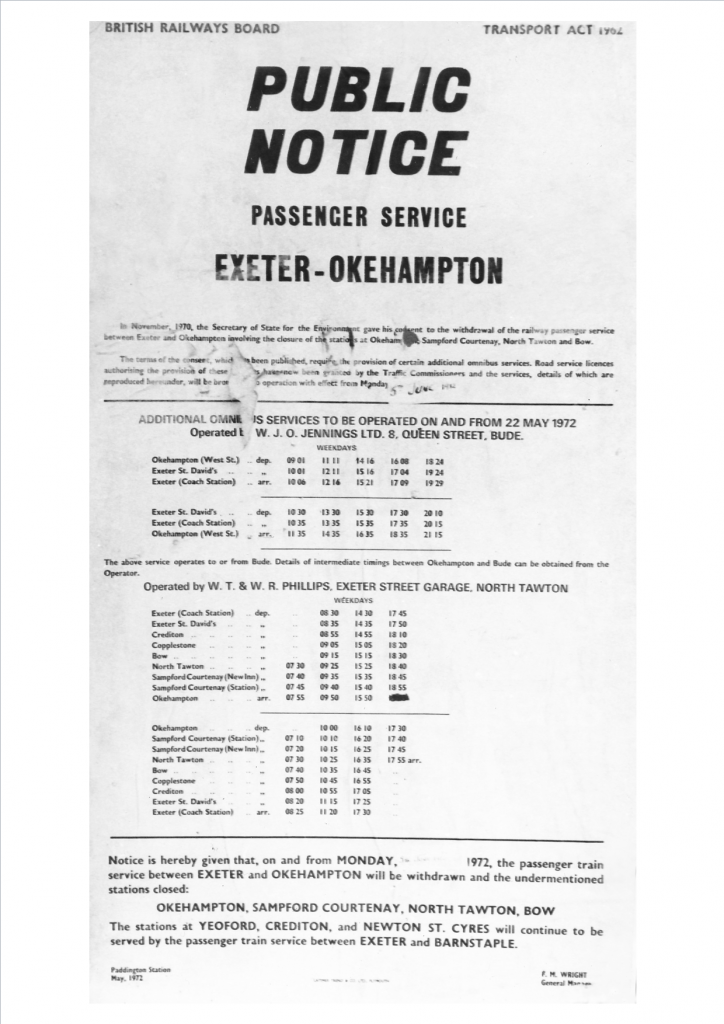
Consent for the withdrawal of the railway passenger service between Exeter and Okehampton had been given by the Secretary of State in 1970. The terms of the consent required additional bus services. Licences were eventually granted by the Traffic Commissioners and the services began to operate from Monday, 5th June, 1972. The last train ran on 3rd June.
Those augmented road services have continued to run and today are combined in Service “6,” Exeter – Bude, via Okehampton and Holsworthy, and “6A,” Exeter – Launceston – Bude, via Okehampton, run by Stagecoach. The first bus departs Bude at 0533 and the last arrival from Exeter is 2220.
The old L. & S.W.R. main line is mostly between three and five miles north of the turnpike and the routes do not cross until the outskirts of Okehampton, where the bus descends to the town and the railway makes for the edge of the moor.
At first, buses had to share the turnpike with all the arterial traffic but, gradually, with the opening of sections of new A30 dual carriageway, the turnpike was declassified and became a quiet back road. This culminated with the opening of the Okehampton Bypass in 1988. Because the turnpike was lost beneath the dual carriageway, nearly 2½ miles between Crockernwell and Whiddon Down is a new road running parallel with the A30.
The old road is so lightly trafficked that it has been adopted as National Cycle Network Route 279, although this follows the original, pre-1823, turnpike via Whitestone to Taphouse (the major part of Tedburn St. Mary on the main road), the continuation of Exeter’s Okehampton Road.
With four hours to spare between leaving his mount at Hardy Cycles and a dental appointment, the scout made his way along Bonhay Road to St. David’s. He wandered around outside and within the station, going over the former luggage trolley bridge to see the new entrance to the traincrew depot and taking the stairs signed “Staff Only” to the middle platform. The 1037 train to Okehampton had gone. It was noted that the cull of unnecessary Tannoy announcements ordered by the Transport Secretary had not been acted upon; there was also a constant narration of the lifts’ progress.
The No. 6 bus appeared beside the old District Goods Manager’s Office at the foot of St. David’s Hill a little behind time.
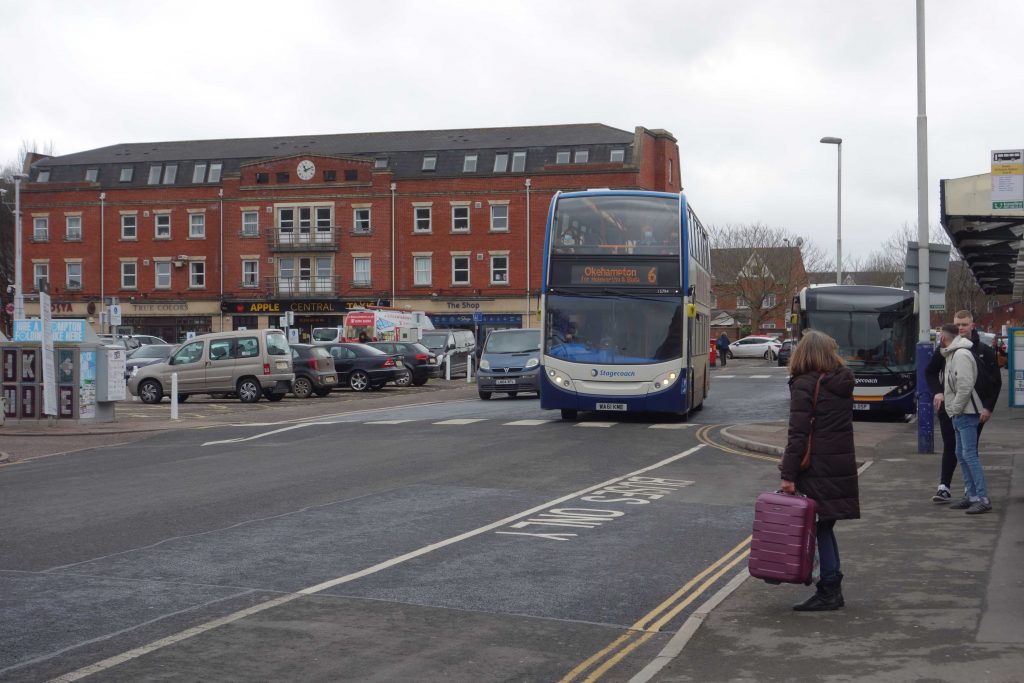
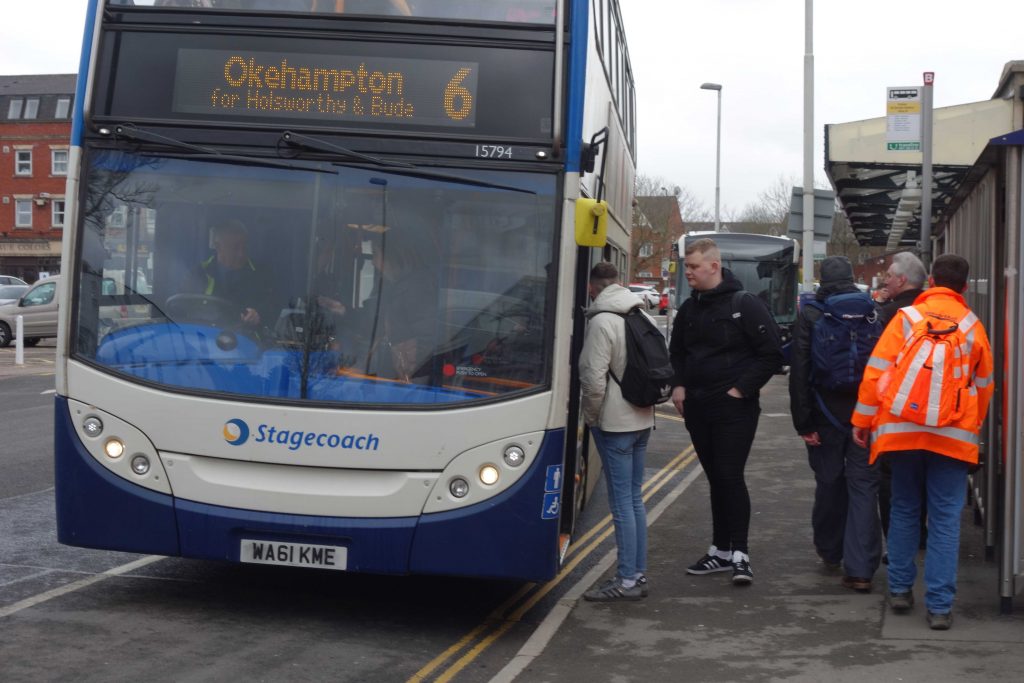
It was not known why the destination blind suggested a change at Okehampton for Bude until an explanation was kindly given by a top busman.
The bus was two late away but was on time passing the St. Thomas Station stop. Traffic was light and there were no passengers at the city stops; just as long distance trains are used intermediately by local passengers, Exeter’s country buses are hailed by passengers journeying within the city. Despite this clear run, the bus was half a minute down leaving Pathfinder. A schedule is attached here. Will bus enthusiasts ever try to imitate Railway Magazine’s “Practice and Performance” column?
Much like the state that the railways got into before drastic action had to be taken, many roads have trees and overgrown hedges which are shaped by high-sided vehicles. Beyond The Traveller’s Rest, the driver pulled over and stopped to allow the oncoming 1015 Launceston to pass, straddling the centre line. And this was before any spring growth.
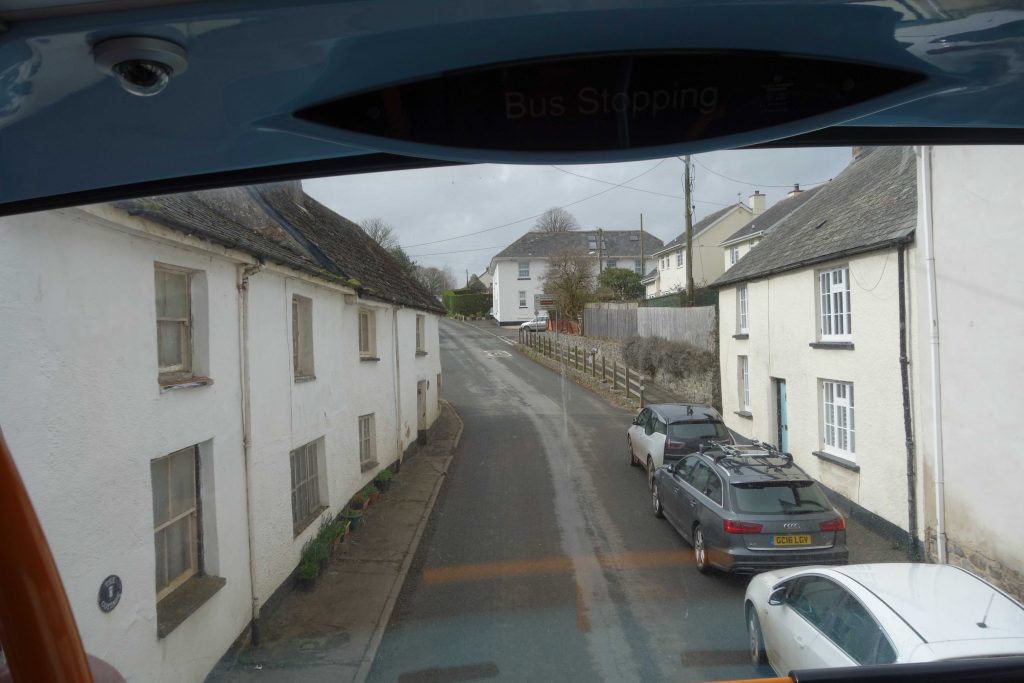
Behind the fence on the other side of the road are the stones marking the meeting place of the Exeter and Okehampton turnpike trusts, at roughly the halfway point.
It is hard to believe that this was the A30 until the village was bypassed by the new dual carriageway, less than a mile to the north, in 1978.
This is a short turnpike bypass: Stonelands, a bit of earlier road, lies behind the cottages at left.
The mileage between Exe Bridge and Okehampton, as chained by the turnpike builders, is 22½. Using a thread of cotton on the O.S. map, the way the scout was taught in geography, produces 24½ miles between St. David’s and Okehampton. It is 25 by rail and 55½ to Bude.
Upon the completion of the infamous bypass, Okehampton had one of the peninsula’s two dual carriageway trunk roads close by, with ready access in both directions. Self-centred transport users then could be in Exeter easily in under half an hour. The problem of course is that at peak times traffic congestion is often met on Dunsford Road, on the old route, and on the Alphington Spur, leading from the dual carriageway onto one of Exeter’s busiest roads.
A “park and ride” facility was mooted for a site at the Alphington junction but the proposal was met with fierce opposition from the villagers of Ide.
When Okehampton people talked about being cut off, they really meant that public transport was poor or unreliable. For although a vast sum of public money was spent on the new road, including the fight to push it through the priceless landscape of the national park above the town, it sees very little use by service buses; in fact none at all on the section which caused the greatest environmental despoliation.
The only length that is used daily is between Whiddon Down and Tongue End, which surprisingly is only a quarter of a mile shorter than the turnpike. Five journeys are made by the Exeter-Bude service and six by return workings, which save five or six minutes and avoid nine or ten stops.
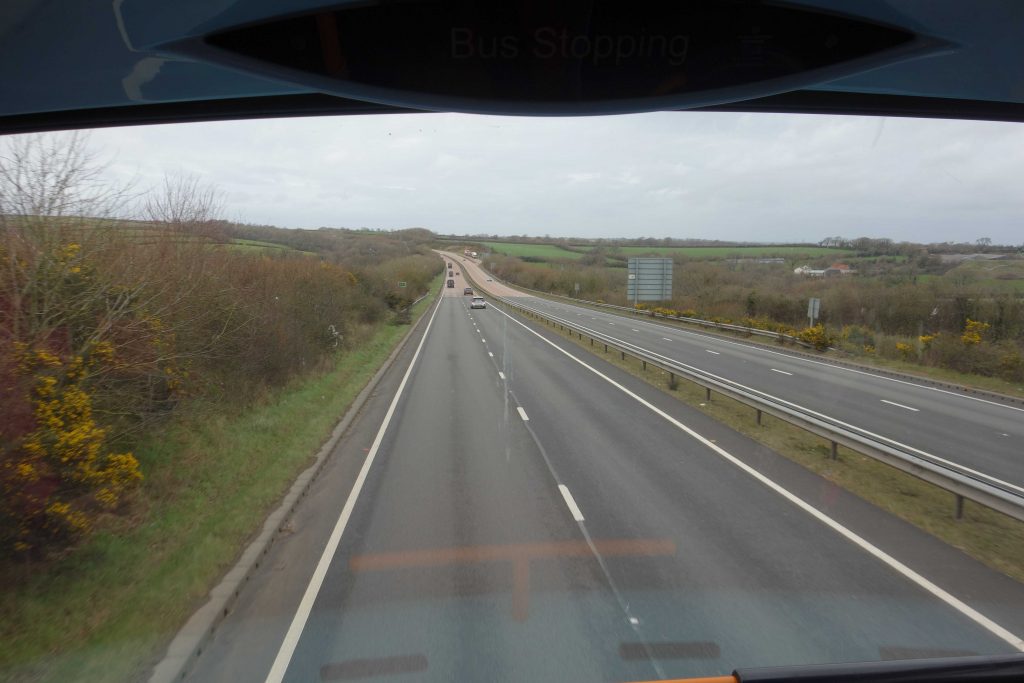
From here the riding becomes much more like a train, with the only annoyance being minor steering corrections which are probably felt more on the top deck; possibly the servos react to the merest touch of the wheel. The scout did not think to note the times so as to get an average speed. It’s hard to tell with large vehicles, but it is thought that the bus kept to around 50 m.p.h.
In the summer of 2020, the scout rode from Christow towards Hittisleigh and joined the A30 here, keeping to the narrow “lane” on the left.
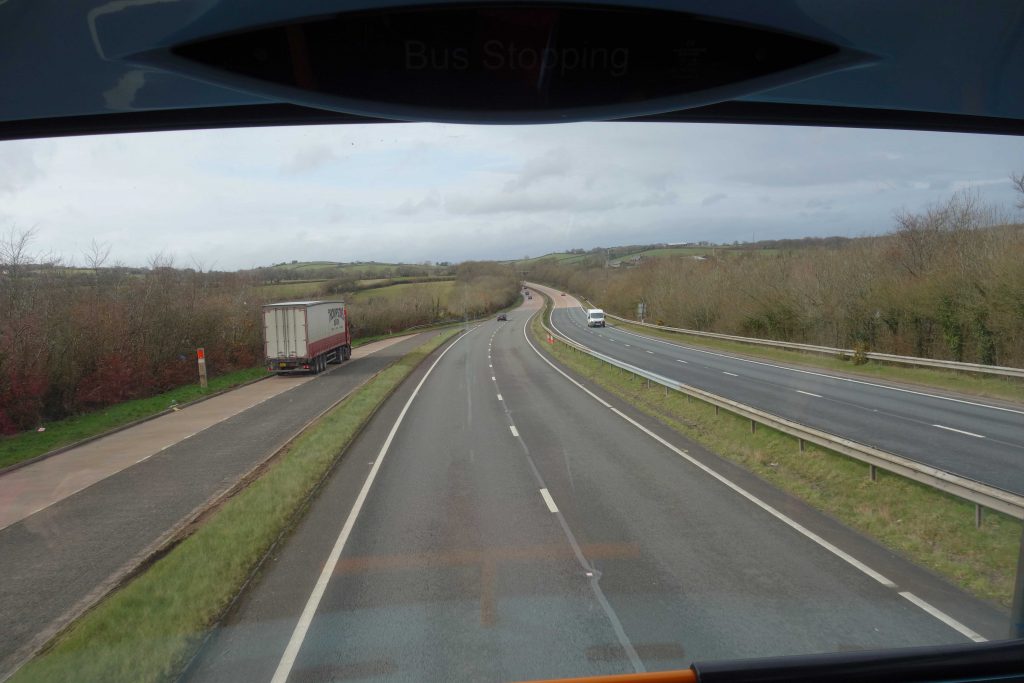
Were an express bus service to run between Tongue End and Alphington, and were there to be bus lanes, a dedicated route to St. David’s and the city centre, or other priority measures, then it would be quicker overall than the trains. If Stagecoach Gold buses, or their equivalent, were run, the level of comfort would arguably surpass that of a D.M.U. The service would for the most part be unsupported, as are the “6” and “6A” now.
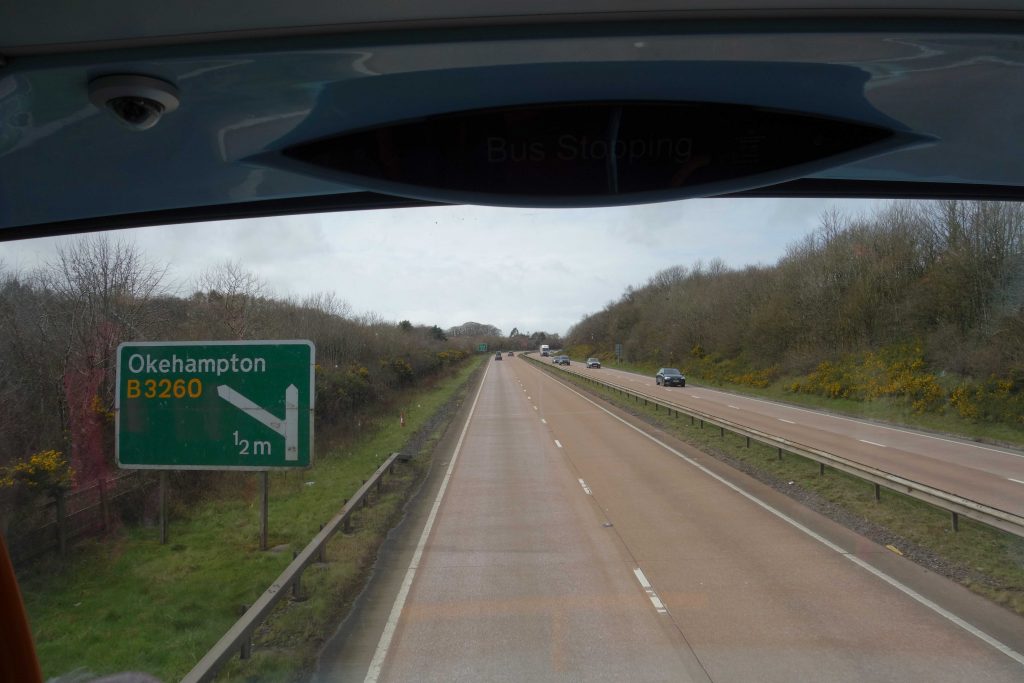
Being confined to them can be frustrating; the scout has been known to get fed up and clamber down an embankment to join another road or path.
With unrelenting sun on him, the scout remembers weakening here on the climb to Tongue End. He bought his lunch at the shop there and was glad to eat it in the shade at Okehampton Station.
A passenger rang the bell as the bus neared the town centre. The scout, brought up with open-platform half-cabs, had ignored the notice instructing passengers to remain seated until the bus stops, and was holding the rail at the foot of the stairs. The driver stopped opposite McColl’s and the scout was the only one to alight. The bus and its half-dozen passengers quickly moved off and was on time at the West Street stop beyond the crossroads. There didn’t seem to be any reason for the one-late departure. At least no passenger who cuts it fine has to watch the doors closing a full minute before the bus actually moves.
The bus had brought the scout to the centre of Okehampton in 50 minutes, with five stops. The fare had been £3.80 (£3.20 if he’d been given a return). Had he caught the 1037 train from Exeter, with its one stop, and the “118” connecting bus from Okehampton Station, the journey would have taken 57 minutes for fares adding up to £5.
The bus could have stopped seven times within the city beyond St. David’s and a further 23 times before West Street. There are a staggering 91 timed stops between Exeter and Bude. In practice, only a small fraction are serviced by each journey.
Half an hour was only long enough for an amble around the town centre, which was very quiet. There was but one other customer in the sizeable McColl’s, where the scout bought a sandwich to eat on the return journey.
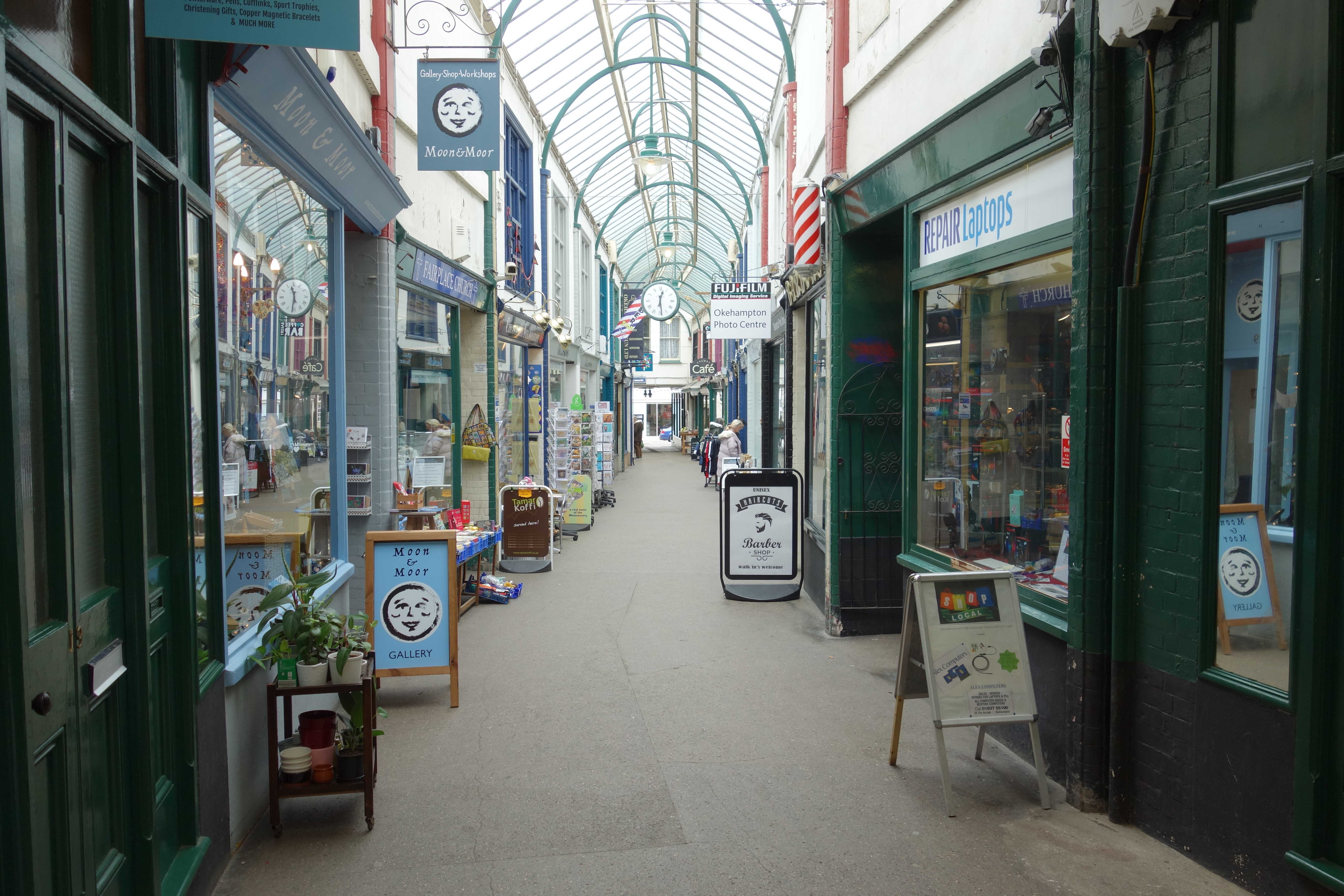
Compared with railway timetables, those that buses run to seem a bit loose. The 1245 to Exeter is formed by the 1140 Exeter, which is booked to arrive at 1245. Further, it is shown as departing West Street and McColl’s at the same time, and at three more stops a minute later. It is not known whether there is a “working” version; drivers are seen referring to a diagram, which may only be a simplifier.
Being upstairs meant the scout did not see what went on at Monkey Puzzle, where the bus dwelt for around three minutes. A fellow in a yellow jacket who must have driven from the town was seen getting off and a lady driver was at the wheel in Exeter. Maybe a driver has to do a quick “book up” before being relieved.
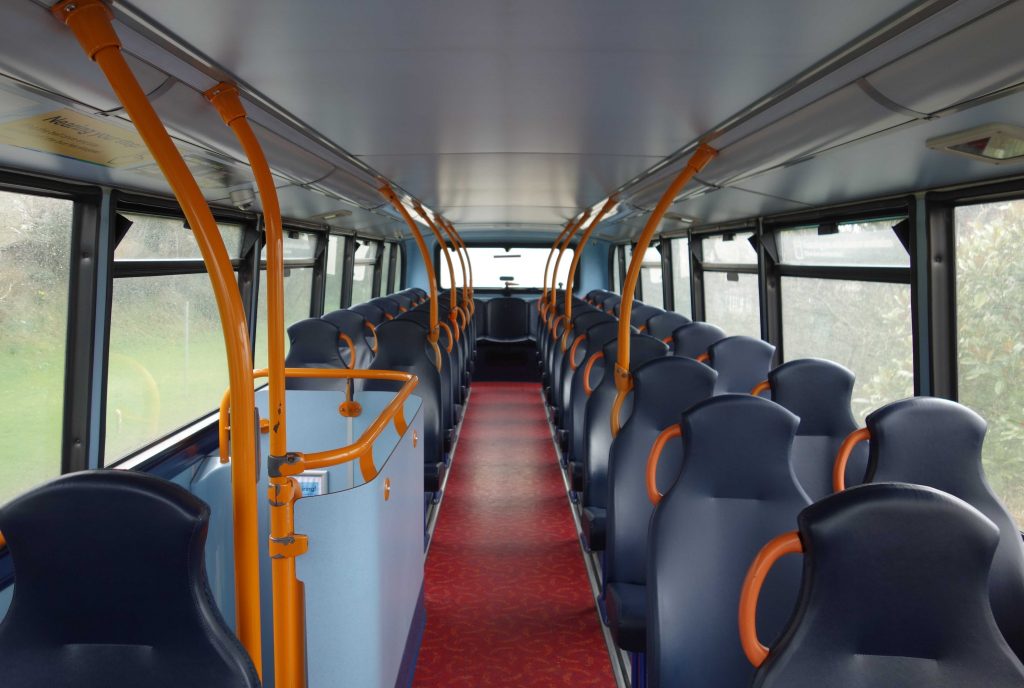
Would any of these 46 empty seats and many more downstairs have been taken by passengers who caught a train instead?
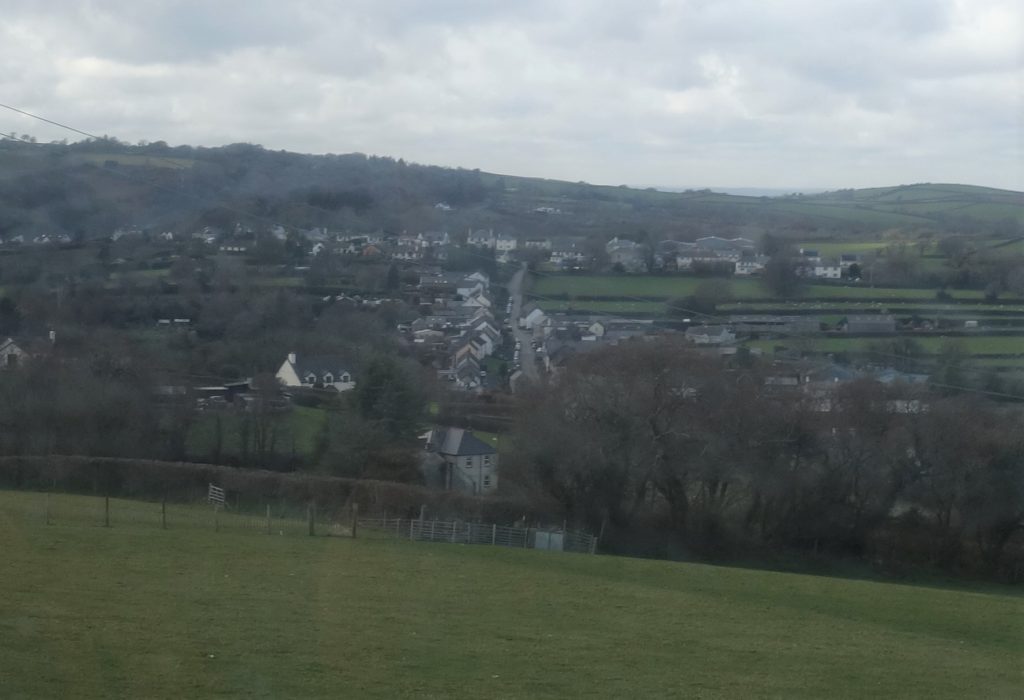
“Anyone seen on a bus after thirty must be a loser.”
This remark, or one like it, is often attributed to a former Prime Minister, but the insult must have been expressed before her time. And a great many who do not say as much, certainly think it. One of the reasons trains and trams get motorists out of their cars, when buses do not, is the perception that buses are a poor man’s form of transport. Think of the teenagers who yearn to escape the bus, never to return, after their learning years; of the retired folk who continue to run an expensive car and endure road conditions they can scarcely cope with when they could enjoy free bus travel; of middle class types who think of the bus as beneath them; and of all those who will not think of catching a bus even when it is the most sensible and convenient way of getting about. Given that buses are by far the most common form of public transport, which could empty the streets of cars in towns and cities, and could go wherever country roads allowed, the attitude towards them that has crept in since the era of mass car ownership began in the 1950s is thoroughly regrettable.
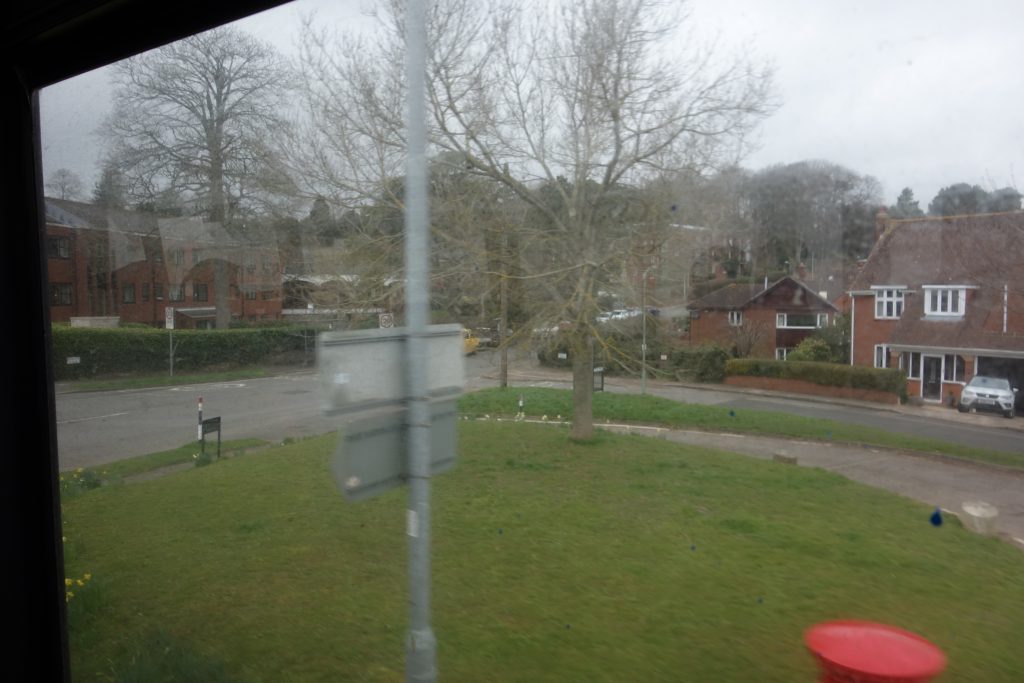
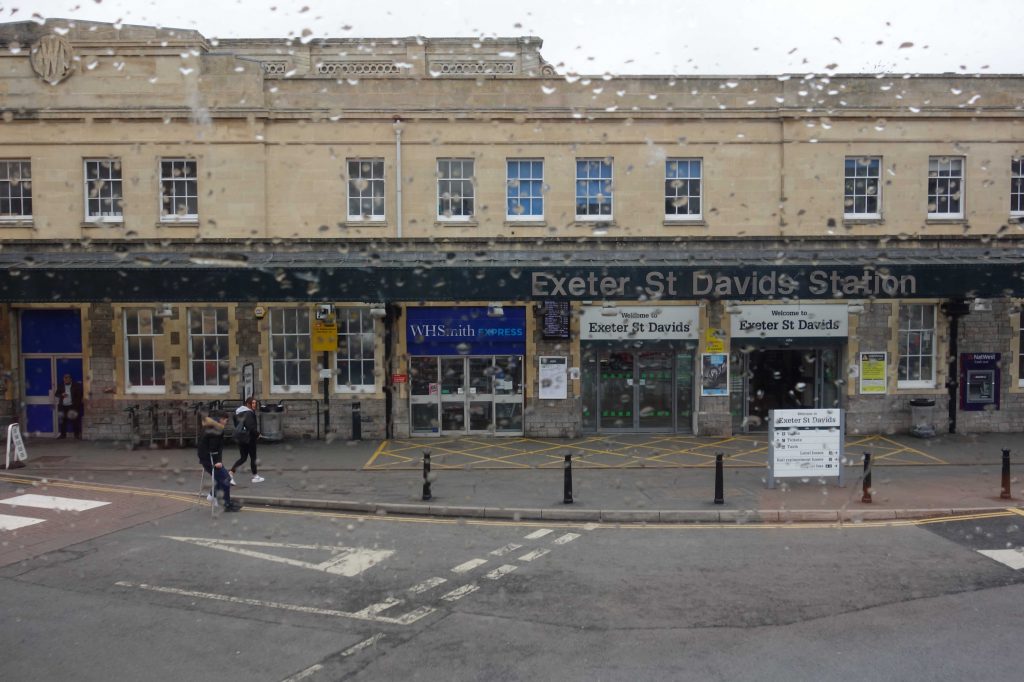
There have been many superficial changes to the station frontage in the scout’s time, but the G.W.R. roundel monogram (top left) remains from the 1930s alterations.
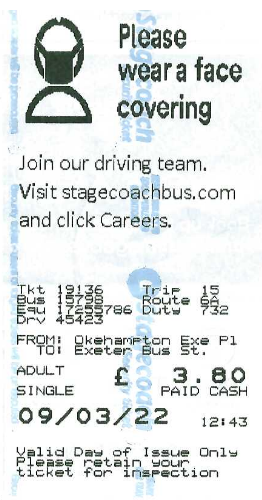
After just over an hour from Okehampton, the bus pulled into Exeter’s shining new station, not a quarter of a mile from the scout’s dentist’s surgery. The “6A” follows the turnpike all the way and there are 31 possible stops before the city and another 11 within it. Had the scout waited in Okehampton for the 1310 bus to the station, the journey to Exeter Central would have been 57 minutes overall.
The scout wondered how many generations of buses there had been in the time of two generations of D.M.U. The relatively short service life of road vehicles enables constant improvement and this was evident in the very well designed type of bus caught on this occasion. They have rapid acceleration and can gallop if given their heads. The seating and ride are less comfortable than trains, but buses are much at the mercy of the road surface; the former A30 is very poor in places. As was said, on the dual carriageway the running was smooth and it is imagined that Gold vehicles would more closely rival the train.
And the sheer vigour of motor manufacturers, who have many hundreds of electric cars already in production, almost ruling out any rational consideration of how transport as a whole could or should develop, will ensure that the buses which outwardly are “zero emissions” will be on the road to Okehampton before an equivalent train is on the rails.
Train and bus form two very different services. The railway line has been reopened but not one of the three intermediate stations on the old Devon & Cornwall, which were anyway remote from their settlements. In his West Country Railway History, David St. John Thomas remarked that ” … the railway’s first accomplishment was to transfer much trade [from Okehampton] to Exeter.” It must be hoped that the same does not happen again. The author also wrote of North Tawton: “Until 1865 it was almost Okehampton’s size, with a woollen and a flour mill. Both mills closed upon the railway’s arrival; shops lost trade as the unemployed mill workers drifted away and big shops elsewhere attracted local custom.” Although the origin of Gregory Distribution, North Tawton’s largest employer, was connected with the station, the modern firm has no interest in rail transport. Sampford Courtenay, North Tawton and Yeoford people have petitioned for their stations to be restored.
As it is, the train runs the 18 miles from Crediton to Okehampton non-stop, but does not gain a great advantage over the bus. Would a passenger from Bude, Holsworthy or Launceston, travelling with luggage to St. David’s to catch a train, get off the bus in Okehampton to wait for the “118” or remain in his seat?
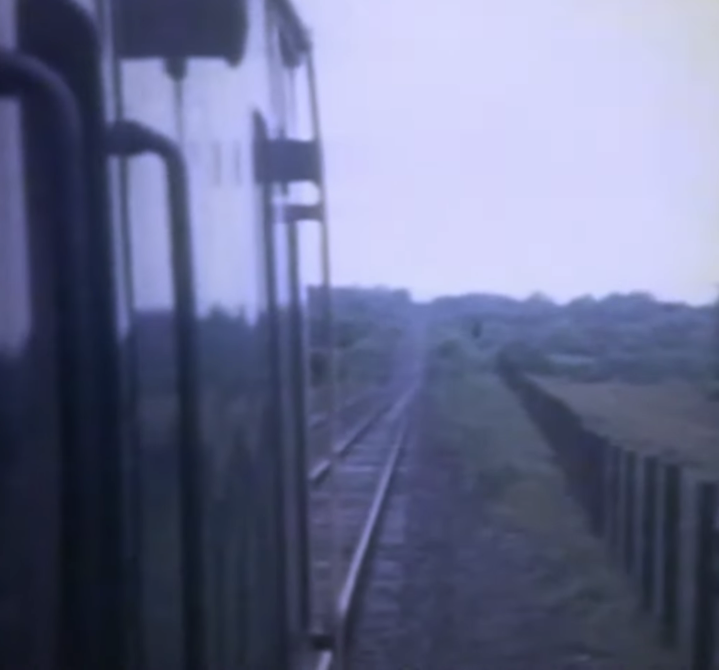
The views from the railway, which takes the direction of the Roman road, were never the best but at least they were unconstrained, except by cutting walls. Now the line is an avenue of trees, which in a few months will block much of the light and what glimpses of the scenery that could have been had in winter. For someone who remembers sitting behind the driver and seeing part of Devon’s longest straight dropping to a dip and rising again to a brow, or being able to stand at an open window, the modern sealed train with no view forward or back, and a poor view from the side, is a miserable experience.
By contrast, four bus passengers can sit in an incomparable position behind the windscreen on the top deck and enjoy what could be sold as a scenic route. The views from the ancient ridgeway, especially beyond Whiddon Down, are superb. The railway offers nothing like looking down on South Zeal, bypassed by the turnpike, or drifting through lovely Sticklepath.
Staff at Christow look upon buses as feeders or basic public transport which generally only serve places without trains. The Exeter to Okehampton road naturally demands a bus service; it appears as the northernmost route on the East Dartmoor route map, but no one in the ideal world illustrated would make the journey in its entirety, except for the pleasure of it.
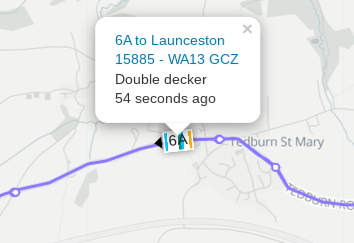
In the real world of today, bus operators nationwide are in difficulty, mostly because of reduced travel and restrictions during the plague. Stagecoach has revealed in its company magazine that in the last two years the number of drivers in the South West has fallen from 1,014 to 833, the vehicle fleet has been reduced from 400 to 324 and that there have been many fewer miles run. It is therefore unlikely that “6” and “6A” will have been unaffected.
The services that the scout chose were provided almost perfectly and they demonstrate a standard that, if maintained, would be very satisfactory. If the scout had found himself stuck in Okehampton because of late running or a cancellation and had had to pay a hefty fee for a missed dental appointment, or if he had been left waiting in the pouring rain at one of the remote stops, then this report would read very differently. The scout enjoyed the novelty of the bus rides but is well aware that a regular, bus-dependent passenger’s experience could be far from fun.
It would be unfortunate if spending a vast sum of money on reopening the railway, with heavy subsidy in perpetuity, as something to show for the “Restoring Your Railway” sham, led to the operator of the only public transport Okehampton had had for fifty years finding that his unsupported services, penetrating the district, had become less viable.
October, 2022: The “6” and “6A” timetables were completely recast from 30th October, with all buses terminating at Okehampton Station. This may have been brought about by driver shortages or by changes in travel patterns. Whatever the reason, the reduction between Exeter and Okehampton from 12 buses each way to five or six, with none taking the A30 short cut, and between Okehampton and Bude from eight or nine buses to five, has greatly diminished the service to a lot of outlying places, as well as causing some through passengers to have to change buses.

